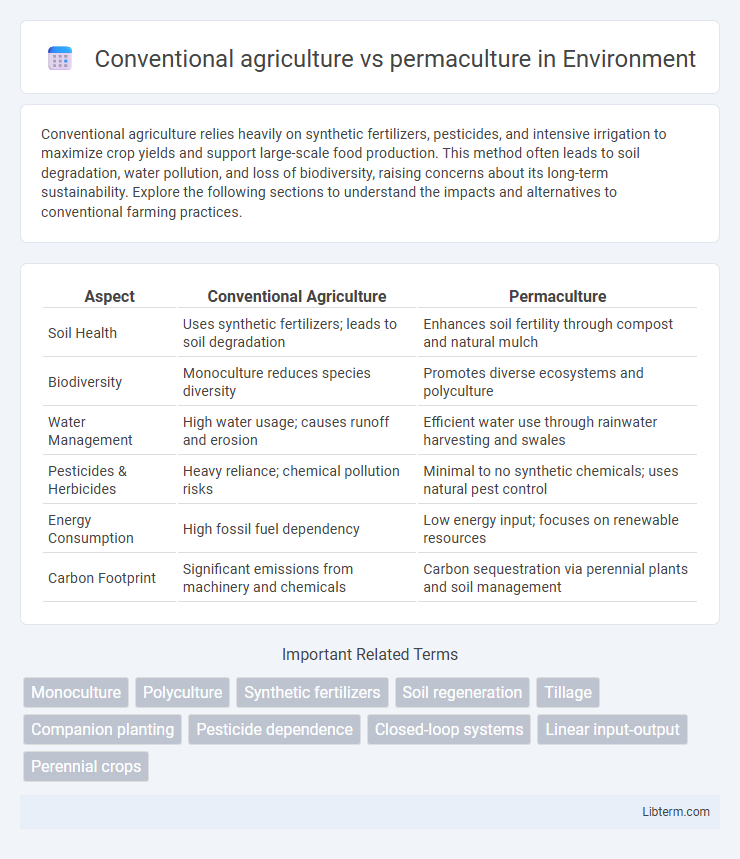Conventional agriculture relies heavily on synthetic fertilizers, pesticides, and intensive irrigation to maximize crop yields and support large-scale food production. This method often leads to soil degradation, water pollution, and loss of biodiversity, raising concerns about its long-term sustainability. Explore the following sections to understand the impacts and alternatives to conventional farming practices.
Table of Comparison
| Aspect | Conventional Agriculture | Permaculture |
|---|---|---|
| Soil Health | Uses synthetic fertilizers; leads to soil degradation | Enhances soil fertility through compost and natural mulch |
| Biodiversity | Monoculture reduces species diversity | Promotes diverse ecosystems and polyculture |
| Water Management | High water usage; causes runoff and erosion | Efficient water use through rainwater harvesting and swales |
| Pesticides & Herbicides | Heavy reliance; chemical pollution risks | Minimal to no synthetic chemicals; uses natural pest control |
| Energy Consumption | High fossil fuel dependency | Low energy input; focuses on renewable resources |
| Carbon Footprint | Significant emissions from machinery and chemicals | Carbon sequestration via perennial plants and soil management |
Introduction to Conventional Agriculture and Permaculture
Conventional agriculture relies on monoculture, synthetic fertilizers, pesticides, and heavy machinery to maximize crop yields and efficiency. Permaculture emphasizes sustainable, regenerative practices inspired by natural ecosystems, integrating diverse plant species and organic inputs to improve soil health. Both approaches impact ecosystems differently, with conventional methods often leading to soil degradation while permaculture promotes biodiversity and resilience.
Core Principles and Philosophies
Conventional agriculture emphasizes maximizing short-term crop yields through monoculture, synthetic fertilizers, and pesticides, prioritizing efficiency and large-scale production. Permaculture operates on holistic design principles that mimic natural ecosystems, promoting biodiversity, sustainability, and soil regeneration to create resilient agricultural systems. Core philosophies of permaculture include working with nature, valuing diversity, and pursuing long-term ecological balance rather than immediate financial gain.
Land Use and Ecosystem Impact
Conventional agriculture often relies on monoculture practices, leading to soil degradation, decreased biodiversity, and increased water runoff, which negatively impacts ecosystems. Permaculture emphasizes diverse planting, soil regeneration, and closed-loop systems that enhance soil fertility and promote habitat restoration. This sustainable land use approach reduces environmental harm while supporting biodiversity and ecosystem resilience.
Soil Health and Fertility Management
Conventional agriculture often relies on synthetic fertilizers and intensive tillage, which can degrade soil structure and reduce microbial diversity, leading to long-term fertility decline. Permaculture emphasizes maintaining healthy soil through organic matter addition, crop diversity, and minimal disturbance, fostering robust microbial ecosystems and natural nutrient cycling. This holistic approach enhances soil fertility sustainably, improves water retention, and reduces erosion compared to conventional practices.
Water Usage and Conservation Practices
Conventional agriculture heavily relies on high water inputs, often utilizing flood irrigation or sprinkler systems that result in significant water runoff and evaporation, leading to inefficiencies and resource depletion. Permaculture emphasizes water conservation through techniques such as rainwater harvesting, swales, and mulching, which enhance soil moisture retention and reduce the need for supplemental irrigation. These sustainable water management practices in permaculture promote long-term ecosystem health and resilience against drought conditions.
Crop Diversity and Pest Control
Conventional agriculture often relies on monocropping, which limits crop diversity and increases vulnerability to pests, frequently necessitating chemical pesticides for pest control. Permaculture promotes diverse polycultures that enhance ecosystem resilience and naturally manage pests through beneficial insect habitats and crop rotation. This biodiversity reduces the need for synthetic inputs and supports sustainable pest control strategies.
Inputs: Fertilizers, Herbicides, and Pesticides
Conventional agriculture relies heavily on synthetic fertilizers, herbicides, and pesticides to maximize crop yields and control pests, often leading to soil degradation and environmental pollution. Permaculture emphasizes natural inputs such as compost, green manure, and biological pest control methods to maintain soil health and biodiversity while minimizing chemical use. This sustainable approach promotes long-term ecosystem resilience and reduces dependency on external chemical inputs.
Economic Viability and Productivity
Conventional agriculture often achieves higher short-term yields through intensive use of synthetic fertilizers and pesticides, leading to immediate economic returns but increasing long-term input costs and soil degradation. Permaculture emphasizes sustainable productivity by integrating diverse plant species and natural ecosystems, reducing external inputs and enhancing soil health, which can improve economic viability through lower operating expenses and resilient yields over time. Economic analysis shows permaculture can be more profitable in the long run due to reduced input costs and ecosystem service benefits, despite potentially lower initial output compared to conventional methods.
Environmental Sustainability and Climate Resilience
Conventional agriculture relies heavily on chemical inputs and monoculture practices, leading to soil degradation, biodiversity loss, and increased greenhouse gas emissions, which compromise environmental sustainability. Permaculture emphasizes regenerative farming techniques, biodiversity, and closed-loop systems that enhance soil health, sequester carbon, and improve ecosystem resilience against climate change. Adopting permaculture principles can significantly boost climate resilience by promoting water conservation, reducing vulnerability to extreme weather, and supporting long-term agricultural productivity.
Future Trends and Global Implications
Conventional agriculture relies heavily on synthetic inputs and monoculture, which contribute to soil degradation and biodiversity loss, signaling a pressing need for sustainable alternatives. Permaculture emphasizes regenerative practices, biodiversity, and ecosystem balance, offering resilience against climate change and enhancing food security worldwide. Future trends indicate a growing adoption of permaculture principles driven by global demands for sustainable agriculture and carbon footprint reduction.
Conventional agriculture Infographic

 libterm.com
libterm.com